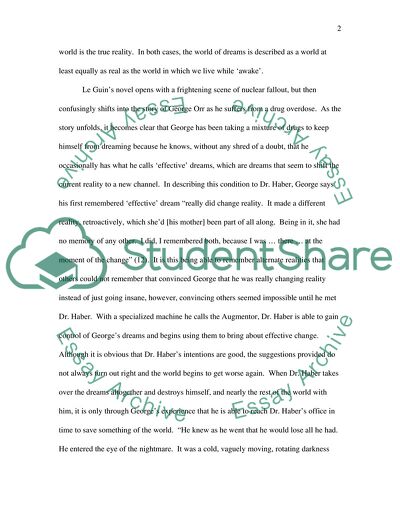
- Home
- Free Samples
- Premium Essays
- Editing Services
- Extra Tools
- Essay Writing Help
- About Us
- Studentshare
- Subjects
- Miscellaneous
- Some comparison of the use of dreams and dreaming as themes in the The Lathe of Heaven by Ursula K. Le Guin and The Moon is Drowning While I Sleep by Charle
Some comparison of the use of dreams and dreaming as themes in the The Lathe of Heaven by Ursula K. Le Guin and The Moon is Drowning While I Sleep by Charle - Essay Example

- Subject: Miscellaneous
- Type: Essay
- Level: Masters
- Pages: 4 (1000 words)
- Downloads: 0
- Author: gradyberneice
Extract of sample "Some comparison of the use of dreams and dreaming as themes in the The Lathe of Heaven by Ursula K. Le Guin and The Moon is Drowning While I Sleep by Charle"
This concept of dreaming reality is an idea that is explored to different effect in the stories of science fiction authors Ursula le Guin and Charles de Lint. In le Guin’s novel The Lathe of Heaven, the main character, George, seeks help to keep himself from dreaming because his dreams have the power to change the world, but no one has power over his dreams. In de Lint’s short story “The Moon is Drowning While I Sleep,” the main character Sophie finds herself questioning the nature of reality itself and which world is the true reality.
In both cases, the world of dreams is described as a world at least equally as real as the world in which we live while ‘awake’. Le Guin’s novel opens with a frightening scene of nuclear fallout, but then confusingly shifts into the story of George Orr as he suffers from a drug overdose. As the story unfolds, it becomes clear that George has been taking a mixture of drugs to keep himself from dreaming because he knows, without any shred of a doubt, that he occasionally has what he calls ‘effective’ dreams, which are dreams that seem to shift the current reality to a new channel.
In describing this condition to Dr. Haber, George says his first remembered ‘effective’ dream “really did change reality. It made a different reality, retroactively, which she’d [his mother] been part of all along. Being in it, she had no memory of any other. I did, I remembered both, because I was … there … at the moment of the change” (12). It is this being able to remember alternate realities that others could not remember that convinced George that he was really changing reality instead of just going insane, however, convincing others seemed impossible until he met Dr. Haber. With a specialized machine he calls the Augmentor, Dr.
Haber is able to gain control of George’s dreams and begins
...Download file to see next pages Read MoreCHECK THESE SAMPLES OF Some comparison of the use of dreams and dreaming as themes in the The Lathe of Heaven by Ursula K. Le Guin and The Moon is Drowning While I Sleep by Charle
The Function Of Dreams
Analysis of LeGuins Book The Lathe of Heaven
Used Romeo and Juliet play with topic: Love is a dream as a theme AND dream vs. reality as a subtopic
What Is Sweet Dreams
Psychology of Sleep and Dreams
Lucid Dreaming and Consciousness
Sleep and Dreams
Lucid Dreaming: What It Is and How It Works

- TERMS & CONDITIONS
- PRIVACY POLICY
- COOKIES POLICY